

William Thomson, 1st Baron Kelvin. Lord Kelvin is widely known for determining the correct value of absolute zero as approximately −273.15 Celsius.
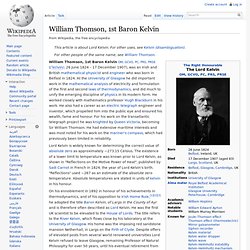
The existence of a lower limit to temperature was known prior to Lord Kelvin, as shown in "Reflections on the Motive Power of Heat", published by Sadi Carnot in French in 1824, the year of Lord Kelvin's birth. "Reflections" used −267 as an estimate of the absolute zero temperature. Kelvin. The kelvin is a unit of measurement for temperature.
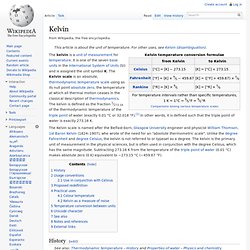
It is one of the seven base units in the International System of Units (SI) and is assigned the unit symbol K. The Kelvin scale is an absolute, thermodynamic temperature scale using as its null point absolute zero, the temperature at which all thermal motion ceases in the classical description of thermodynamics. The kelvin is defined as the fraction 1⁄273.16 of the thermodynamic temperature of the triple point of water (exactly 0.01 °C or 32.018 °F).[1] In other words, it is defined such that the triple point of water is exactly 273.16 K. The Kelvin scale is named after the Belfast-born, Glasgow University engineer and physicist William Thomson, 1st Baron Kelvin (1824–1907), who wrote of the need for an "absolute thermometric scale". Unlike the degree Fahrenheit and degree Celsius, the kelvin is not referred to or typeset as a degree. History[edit] Usage conventions[edit]
William Thomson - Lord Kelvin. Lord Kelvin biography - Science Hall of Fame. Famous for: Devising the absolute temperature scale, now called the 'Kelvin scale' Formulating the second law of thermodynamics Working to install telegraph cables under the Atlantic.
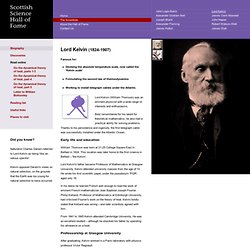
Lord Kelvin (William Thomson) was an eminent physicist with a wide range of interests and enthusiasms. Best remembered for his talent for theoretical mathematics, he also had a practical ability for solving problems. Thanks to his persistence and ingenuity, the first telegraph cable was successfully installed under the Atlantic Ocean. Early life and education. Who's Who in Glasgow in 1909: THE LATE RIGHT HON. LORD KELVIN [ebook chapter] / George Eyre-Todd, 1909. Previous | Contents | Next AFTER a long life of unwearied and unrivalled achievement, Lord Kelvin stands to-day in a place of universal honour, unquestionably the greatest and most revered man of science of our time. His grandfather was a Scottish Ulsterman, tenant of a small farm at Annaghmore, Ballinahinch, County Down. His father, James Thomson , born there in 1786, intended first to become a Presbyterian minister, and studied at . But after taking his degree in 1812 he accepted an appointment as teacher in Belfast Royal Academical Institution, and became Professor of Mathematics when the collegiate department was added to that school.
He received the degree of LL.D. from Glasgow University in 1829, and three years later was appointed Professor of Mathematics in the old College in High Street. William Thomson, Lord Kelvin, was born at Belfast 26th June, 1824. Meanwhile he continued to produce invention after invention. William Thomson, Lord Kelvin. William (Thomson), 1st Baron Kelvin of Largs, physicist, mathematician, engineer and inventor, was born on 26 June 1824 in Belfast, Northern Ireland.
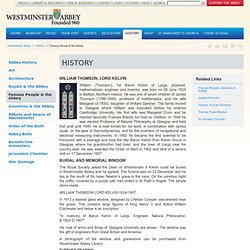
He was one of seven children of James Thomson (1786-1849), professor of mathematics, and his wife Margaret (d.1830), daughter of William Gardner. The family moved to Glasgow where William was educated before he entered Cambridge University. His first wife was Margaret Crum and he married secondly Frances Blandy but had no children. In 1846 he was elected Professor of Natural Philosophy at Glasgow and held that post until 1899. He is best known for his work, in combination with James Joule, on the laws of thermodynamics, and for the invention of navigational and electrical measuring instruments.
Burial and memorial window The Royal Society asked the Dean of Westminster if Kelvin could be buried in Westminster Abbey and he agreed. In 1913 a stained glass window, designed by J.Ninian Comper, was erected near the grave. KELVIN TEMPERATURE SCALE - Chemistry Glossary. Kelvin is a temperature scale designed so that zero degrees K is defined as absolute zero (at absolute zero, a hypothetical temperature, all molecular movement stops - all actual temperatures are above absolute zero) and the size of one unit is the same as the size of one degree Celsius.
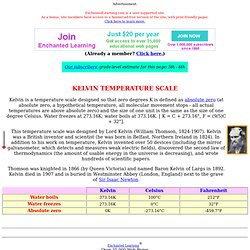
Water freezes at 273.16K; water boils at 373.16K. [ K = C + 273.16°, F = (9/5)C + 32°]. This temperature scale was designed by Lord Kelvin (William Thomson, 1824-1907). Kelvin was a British inventor and scientist (he was born in Belfast, Northern Ireland in 1824). In addition to his work on temperature, Kelvin invented over 50 devices (including the mirror galvanometer, which detects and measures weak electric fields), discovered the second law of thermodynamics (the amount of usable energy in the universe is decreasing), and wrote hundreds of scientific papers. Temperature - Kelvin Scale. Kelvin Scale The Kelvin temperature scale (K) was developed by Lord Kelvin in the mid 1800s.
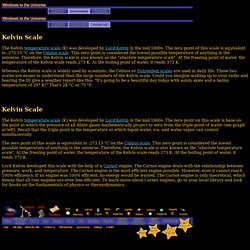
The zero point of this scale is equivalent to -273.15 °C on the Celsius scale. Kelvin temperature scale. History of the Kelvin Scale - Lord Kelvin. Kelvin Temperature Scale Definition - Definition of Kelvin Temperature Scale. Lord Kelvin Biography - Lord Kelvin Childhood, Life and Timeline. Lord Kelvin Childhood William Thomson was born on 26 June 1824 in Belfast, Ireland to mother Margaret Gardner and father James Thomson (a mathematics and engineering teacher at Royal Belfast Academical Institution).
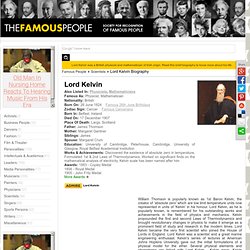
William was the second child born in a family of four children. He lost his mother at a very young age of 6 in 1830. William was educated at home along with his elder brother James. Home tutoring was done by their father while their younger brothers received their education from elder sisters. In 1832 William’s father James Thomson was asked to join as a professor of mathematics at Glasgow which made the family relocate there in October 1833. William suffered from heart problems and was very ill to the brink of dying at the age of 9.
Early Years Thomson started off with his work on mathematics getting inspired and influenced by French mathematician Jean Baptiste Joseph Fourier’s ‘Fourier series’. Career and Scientific Developments Engineering and Other Contributions. Kelvin scale - definition of Kelvin scale by the Free Online Dictionary.